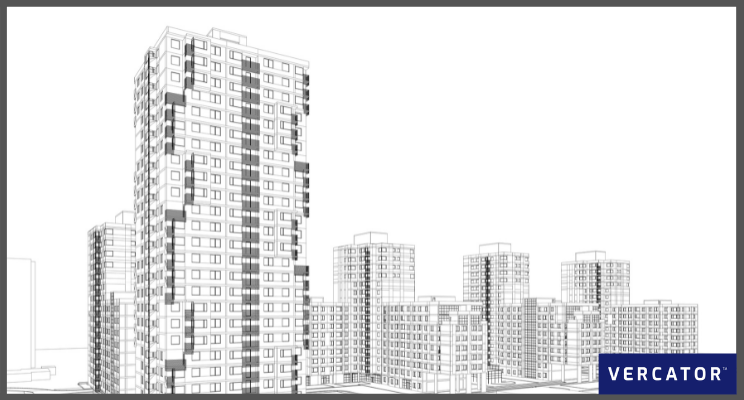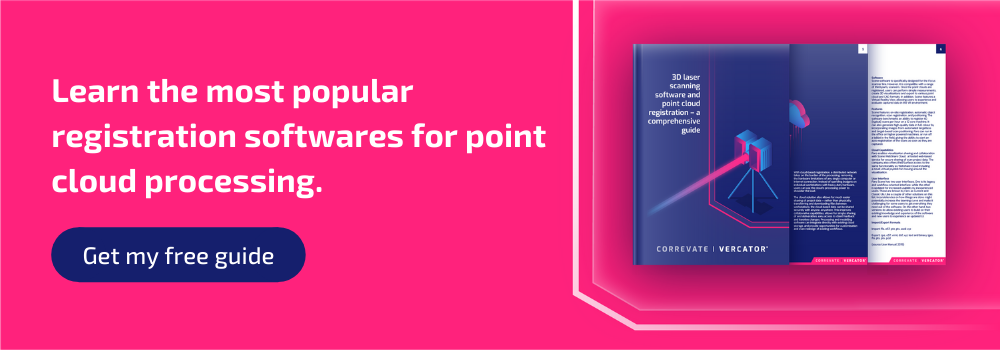Point Cloud Mapping Software Features to Look for in 2021

It could be said there is a ‘point cloud boom’ going on at the moment — fuelled by developments in point cloud registration software. Maturing hardware technology always leads to software innovation. Scanning hardware is now into its third decade, and 3D scanners are managing to become both more comprehensive and simpler to use.
This maturing of scanning hardware has allowed more third parties to enter the market and deliver dedicated software solutions — creating new capabilities spurred on by competition and innovative thinking. Driven by smaller and cheaper scanners, armed with improvements in point cloud registration, laser scanning technology is becoming integral to many diverse projects, and will continue to do so. However, to make the most of these innovative developments, it’s critical to pick the right software, and that means understanding the features available in the market.
At Vercator, we've pulled together some critical capabilities in point cloud registration and processing that are driving change. Each is a feature that you should look for when considering an upgrade to your point cloud mapping software. Let’s get started.
Suggested reading: If you want to learn more about how we’ve contributed to these changes at Vercator, check out our eBook — Point Cloud Processing Has Changed.
Feature 1: Cloud-based processing and storage
Cloud computing has profoundly impacted the use of IT — and point cloud registration is benefiting from it. The cloud brings two distinct benefits to point clouds:
- The storage and sharing of information: Rather than having to send out massive files of scan data to all relevant stakeholders, access is shared seamlessly. Cloud storage can also be dynamically scaled, offering a cheaper way to increase capacity for a large project.
- Processing and registration: The scalability of the cloud isn’t limited to storage, but can encompass computing power as well. This provides the ability to scale up access to match demands of larger projects and processing scans faster on-demand.
The cloud promises near-limitless scalability, delivering far faster registration and more robust outcomes. By itself, the cloud can provide processing acceleration. But the right laser scanning software takes advantage of parallel cloud computing — registering multiple scans simultaneously using multiple processors — to accelerate processing even further.
Pro tip: To truly tap into the scalable computing power of the cloud, point cloud processing algorithms need to automate processing and front load manual inputs — more on that in the next section.
How this impacts outcomes
3D laser scan data is widely accepted as being a 'heavy' data format — it isn't uncommon for a site laser scan project to be terabytes in size. Traditionally, there are operational delays incurred by transferring data sets from data capture specialist to client. Using the cloud, you are no longer limited by file size, number of scans or processing power. This has a knock-on effect in simplifying processes, reducing manual intervention, and improving efficiency.
When used in conjunction with automated processing software, the cloud also makes it possible to rapidly accelerate processing time. This reduces the cost of scan registration, which increases viable application of LiDAR, point clouds and reality capture.
Additional reading: If you want to learn more about how the cloud changes point cloud processing, check out our eBook — Are You Ready for the Cloud?
Feature 2: Automation and front-loading of manual tasks
Advances in point cloud algorithms are dramatically changing the process of capturing and using scan data. AI and registration algorithms enable the automatic alignment and subsequent analysis of point cloud datasets. The use of more robust, vector-based and multi-stage processing techniques means you don't have to stop and start during the registration process. You simply front-load manual tasks and automate large sections of processing. Not only does this accelerate and automate processing, it opens the door to better use of cloud-based scalability to parallelize processing and register scans even faster.
How this impacts outcomes
Historically, processing has been a time-consuming and expensive part of point cloud generation. By automating large portions of registration for hands-off processing, far more efficient workflows can be created. For example, leaving scans to register overnight — in addition to embracing cloud-based scalability.
Point cloud registration software increases the accuracy of measurements and outputs, minimising the risk of unreliable information. Reliable workflows ensure that high-quality models and results are delivered to clients on time. Software can also reduce the need for additional site visits, which means users are working efficiently with reliable and trustworthy data throughout the project workflow.
Feature 3: File format and data type interoperability
There are hundreds of file formats for 3D modelling, as different scanners produce data in multiple formats. Some data formats specified can also add to the file size problem. You need to look out for mapping software that supports the following point cloud file formats at a minimum:
- Data input: ptx, pts. e57, las, laz, ply, fls,zfs, rdbx
- Data output: ptx, pts, e57, xyz, ply, las, laz, rcs
Additional reading: If you want to know more about common point cloud file formats and interoperability, check out our blog — The Most Common 3D Point Cloud File Formats
Sensor Fusion
There is a growing need to process and merge data from multiple sensors. Sensor fusion helps in building a more accurate world model by supporting both mobile and fixed scanning technology. This is an innovation partially spurred by robotic navigation — for example, using point clouds to guide autonomous robotics. However, LiDAR, camera, SLAM and metrology scanners are increasingly all being used in conjunction — creating multiple data sets to deliver complete scene coverage, with different levels of details applied to different segments of the scene.
Each type of sensor has its strengths and weaknesses in terms of cost, quality and efficiency. By combining scans from each, you can exploit strengths while minimising weaknesses. Point cloud mapping software must have the registration capability to align data from a wide range of data capture devices — from drone to terrestrial scanner and SLAM — creating hybrid data sets.
How this impacts outcomes
SLAM data can be used with static laser scanners to deliver total scene coverage. This means a focus on detail only in the areas that matter. Ultimately, the outcome is more scans, produced faster, with the right tools, deployed for each particular job. If you have the software capabilities to pull this all together, the outcome is a far more mobile and flexible workflow able to deliver better and more detailed outcomes.
To make all of this possible, you need the capability to import a large number of file types with many export options. This means you won't find yourself stuck and incapable of accessing data or extracting data for use in another system. However, you do also need point cloud registration software able to deliver seamless registration across different scan types.
Additional reading: If you want to learn more about multi-sensor registration processes using SLAM, check out our eBook — How SLAM Enables the Evolution of Wearable Reality Capture Technology.
Feature 4: Simple site planning and field app support
With modern scanners, it isn't uncommon for hundreds of scan positions to be captured daily. The proliferation of scans requires users to keep accurate details of how on-site scans link together.
In-field mobile applications, usually running on tablets, can pair up scans in sequence live on-site using a simple drag and drop functionality. They also improve site planning and help simplify the creation of each successive scan. This is vital in planning the registration process, and it needs to support anything from a 2D site plan, to a sketched schema on a notepad.
How this impacts outcomes
Building an accurate site network is vital when it comes to processing and registration. In fact, many people still make sketch notes of their site. These paper records, far too often, get damaged or lost, especially when hundreds of scans are being captured. Field apps simplify this process and create a sharable digital record of planning that improves collaboration and quality control.
Feature 5: Object recognition and data classification
Point clouds contain vast amounts of spatial information, but unless that information is processed and labelled, it can't be used effectively or even well understood. Object recognition for point cloud data classification is an essential first step in using point cloud data for successful planning.
Beyond this, feature extraction carries the process one step further, focusing on the surface details of objects. It’s proving invaluable for applications such as reverse engineering, object recognition and autonomous navigation.
How this impacts outcomes
Fundamentally, feature extraction, along with data classification, allows users to interpret physical space rather than simply mapping it. By automating this process, you vastly simplify data classification and feature extraction — making it possible to apply in many more use cases.
Software choices can have a bigger impact than your hardware
Software-driven automation is here now, and it stands to change point cloud data handling forever. A future-focused approach and a future-proofed strategy will make a software-focused solution far more flexible and able to match new opportunities as they arise.
The great thing about a software-driven approach is that many of these developments will be simply integrated into existing software solutions as they are rolled out — particularly if they are cloud-based.
Such advances change the game when it comes to how point clouds are created and what they can accomplish. At Vercator, we’ve pioneered the latest innovations in point-cloud technology and can help you understand and access these opportunities yourself. If you want to learn more, check out our eBook — Point Cloud Processing Has Changed — or get in touch to book a demo of Vercator today.


